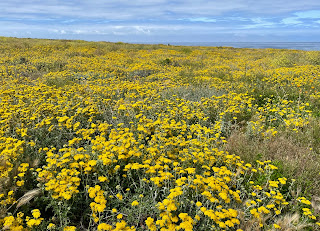Turri Road San Luis Obispo County - The morning adventure begins. Wanting to make the most of every moment, my little Honda inched along at a snail's pace.
A raptor was perched on an old utility pole. I knew it was not a Red-tailed or a Red-shouldered Hawk. While I was mulling over identification, the raptor took flight. It was a female Northern Harrier. My first sighting was a winner!
The first quarter mile is Western Bluebird territory. A pair were perched on top of their nesting box. Both male and female feed the nestlings. Inside the box a hungry chick was wondering when lunch would be served. On both sides of the road Meadowlarks were singing.
My top speed was about five mph, car windows wide open to hear bird songs when suddenly I heard a very loud and piercing Meadowlark song. Oh, my gosh it had flown into the car through the open back window. Well, it had certainly not flown into the car, but for a few moments I was convinced there was a Meadowlark in the backseat.
Continuing up the hill, the mesmerizing beauty of the hills, the deep blue of roadside Lupine, Poppies bursting with life, and glistening fields of yellow Buttercups were a joy to behold. Finally made it to the top of the hill.
Red-winged Blackbirds, from the pond down below, were dashing over the fields. I could even hear Mallard Ducks.
I continued my forward progress. Around the next bend in the road I was anticipating seeing Cassin's Kingbird. Yes! There they were, a pair of Kingbirds, flycatching from an old fence.
Next, the ephemeral cattle pond, my favorite stop. I love the pond, the dilapidated cattle shoot, and the old barbed wire fence (behind the gate) that goes nowhere. Perched on the fence were Western Bluebird, and Cassin's Kingbird.
At the far end of the fence, Tree Swallow's rested, though not for long, but long enough for me to get a good look. Depending on the lighting, their iridescent feathers appear greenish or blueish.
From the wetland across the road came a variety of bird calls** including a female Turkey who had just discovered she was alone. She seemed anxious. From observations of wild Turkeys I have come to the conclusion they get anxious when finding themselves alone, flockless. I'm including a short video on young Turkeys hurrying to join the flock.
https://youtu.be/8RlePt7MDNY?si=QAkuNAKXcFOZyTKm
The morning's birding was positively delightful. What will be the next adventure? Perhaps Raptors, Ravens and Wildflowers?
**Birds heard but not seen - Song Sparrow, Bewick's Wren, Wilson's Warbler, Oak Titmouse, Ruby-crowned Kinglet, Chestnut-backed Chickadee, Pacific Flycatcher, California Towhee, Red-shouldered Hawk.


























.jpg)


















